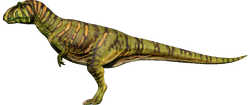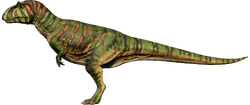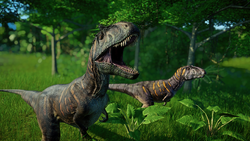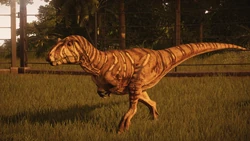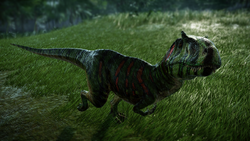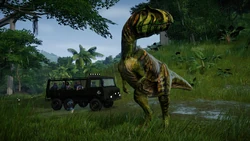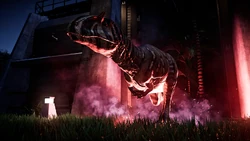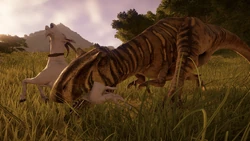| Let me introduce you to the Metriacanthosaurus. Say that fast three times. This is another alpha predator that while not as big as some of his cousins tend to stand more upright so I guess it has good posture while it's tearing you to shreds. |
Metriacanthosaurus is a genus of theropod dinosaur that originated from Late Jurassic Europe. A medium-sized predatory dinosaur and named for its tall vertebrae, Metriacanthosaurus becomes available to the Hammond Foundation's operations in the Muertes Archipelago by achieving the appropriate level of reputation with the Security Division on Isla Tacaño. It is then subsequently found at the Oxford Clay dig site.
History
Metriacanthosaurus was one of the species which InGen had planned to feature at the original Jurassic Park on Isla Nublar; 71% of its genome having been completed by 1993.[1] After InGen was acquired by Masrani Global in 1999, the genome was completed and Metriacanthosaurus became an attraction in Jurassic World's Cretaceous Cruise.[2]
Although Nublar's population of Metriacanthosaurus became wild after the 2015 Jurassic World Incident, over the course of the next three years, the species became extinct once more.[1]
Characteristics
Named after the spines on its vertebrae – the name translates to "Moderately-Spined Lizard" – Metriacanthosaurus was a large theropod that existed and once hunted across Europe during the Late Jurassic period. Despite its relatively large size, 7.6 meters in length and a ton in weight, Metriacanthosaurus preys on large herbivores and can reach speeds of up to 20 mph. Comparatively little is known about this dinosaur compared to its contemporaries like Allosaurus. The base genome of Metriacanthosaurus has a brown body banded with darker brown stripes. It has green stripes on its head and mouth as well as green crests.
Behaviour
Metriacanthosaurus is a fearsome medium-sized predator that can live alone or in pairs. While its incubation cost is relatively high, it has a lower exhibit size requirement than Spinosaurus or Ceratosaurus and has a high resilience to illnesses compared to other larger carnivores. Metriacanthosaurus has a high attack and a medium defense, so it is advised to contain them in strong fences. Overall, however, it is one of the more docile and easy to keep predators.
Metriacanthosaurus will engage against larger or similarly sized predators like Ceratosaurus or Suchomimus so it is recommended not to house them together. Metriacanthosaurus can, however, cohabitate reasonably well with small carnivores like Deinonychus.
Paleontology
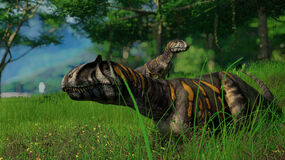
Two Metriacanthosaurus.
Metriacanthosaurus was first described in 1923 by German paleontologist Friedrich von Huene, although the first fossils found – parts of a backbone and leg bones – were initially attributed to Megalosaurus. As a result, Metriacanthosaurus was one of the unfortunate victims of the Megalosaurus 'wastebasket' taxon from remains found in Oxford Clay in the UK. During the early days of paleontology, scientists studying dinosaurs had tended to sweep many fossils under a single genus without much thorough study. Many large carnivores were simply named new species of Megalosaurus. Even Dilophosaurus was once considered a species of Megalosaurus until the 1940s.
However, further research throughout the 20th Century led to it being reclassified as Altispinax, and finally Metriacanthosaurus was officially renamed in 1964 when English paleontologist Alick Walker declared that the bones were that of a new genus. Additionally, it given a new family, the Metriacanthosauridae, an off-shoot of the Allosaurids, which also includes species such as the Yangchuanosaurus from China. Metriacanthosaurus is a mysterious animal as its only known fossils are that of its spine and pelvis. Interestingly, it has a raised spine, suggesting it may have had a hump or ridge running down its back.
Paleoecology
Metriacanthosaurus lived around 160 million years ago on the south coast of England, using the thick forests and jungles that grew during this period to sneak up on its prey. Its diet consisted mainly of other dinosaurs as well as some marine reptiles that swam near the shores. Although it was a medium-sized predator, Metriacanthosaurus was one of the top predators of the Oxford Clay along with species such as Eustreptospondylus. It lived with the ornithopod Callovosaurus, the stegosaur, Lexovisaurus, several types of sauropods and pterosaurs, and a myriad of marine reptiles that inhabited the warm shallow seas of the region. Oxford Clay contains a rich variety of remains including marine animals, indicating that Metriacanthosaurus hunted in coastal regions and near waterways.
Available genomes
| Fossil icon | Dig site | Quality | Number available |
|---|---|---|---|
| Oxford Clay | ★ ★★ ★★★ ★★★★ |
2 6 12 8 |
Skins
Behind the scenes
Metriacanthosaurus is one of the species that, despite being canon, has not appeared in any of the Jurassic films yet. So instead, the development team took inspiration from the design that is used in the promotional websites for Jurassic World, created by the renowned paleoartist Julius T. Csotonyi[2]
The Metriacanthosaurus was first revealed to be in the game in the pre-order trailer that was released in March of 2018,[3] and later received a Species Profile a month after.[4]
Gallery
References
- ↑ 1.0 1.1 What Killed the Gene Guard Act?. (February 23, 2018). Dinosaur Protection Group. Retrieved March 20, 2021.
- ↑ 2.0 2.1 Metriacanthosaurus. Jurassic World. Archived from the original on December 1, 2016.
- ↑ Frontier Developments. (March 29, 2018). Jurassic World Evolution Pre-Order Trailer [Video]. YouTube. Retrieved October 26, 2019.
- ↑ Frontier Developments. (April 6, 2018). Species Profile - Metriacanthosaurus [Video]. YouTube. Retrieved October 26, 2019.
External links
- Metriacanthosaurus on Wikipedia




